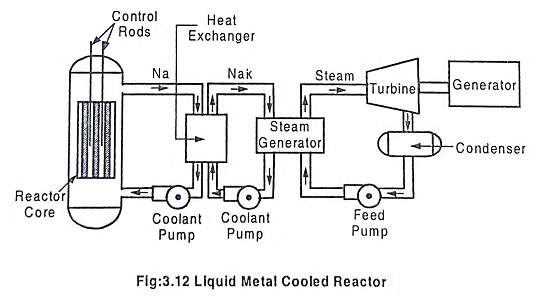Liquid Metal Cooled Reactor (LMCR) – Working, Advantages & Disadvantages:
A liquid metal cooled reactor (LMCR) is an advanced type of nuclear reactor that uses a liquid metal as the primary coolant. The use of liquid metal has many advantages because the reactor need not to be kept under pressure and they allow high power density than the conventional coolant. The high temperature of the liquid metal is used to produce vapour at higher temperature leading to higher plant efficiency.
Sodium-Graphite Reactor (SGR) is a typical liquid metal cooled reactor that uses sodium as coolant and graphite as moderator.
Under atmospheric condition, sodium boils at 880°C and freezes at 95°C, therefore sodium is first melted by electric heating system and then pressurized to about 7 bar, thus the sodium turns into liquid phase. The liquid sodium is then circulated by the circulation pump.
The arrangement of a sodium graphite reactor (SGR) is shown in Fig. 3.12.
The reactor has two coolant loop. The primary loop contains liquid sodium which is circulated through the fuel core and it absorbs the heat liberated by the fission of fuel. The liquid sodium gets cooled in the heat exchanger and goes back to the reactor vessel. The secondary loop contains an alloy of sodium and potassium in liquid form. This liquid takes heat from the heat exchanger and then passes through a boiler.
Feed water from the condenser enters the boiler, the heated sodium potassium liquid passing through the tube gives heat to the water thus converting it into steam (superheated). Graphite is used as the moderator in this reactor.
Advantages of sodium graphite reactor:
- Thermal efficiency is high.
- Coolant need not be pressurized.
- Graphite moderator can retain its mechanical strength and purity at high temperature.
- Production of superheated steam and excellent heat removal.
Disadvantage of sodium graphite reactor:
- Sodium reacts violently with water and air.
- Leakage of sodium is dangerous.
- Leak proof heat exchanger must be used, which increases extra cost.
- Difficulties in inspection and repair.
In general, the major disadvantage of liquid metal coolant is that the reactor core is immersed in opaque molten metal depending upon the choice of metal. And fire hazard risk, corrosion and production of radioactive products are other threats.
